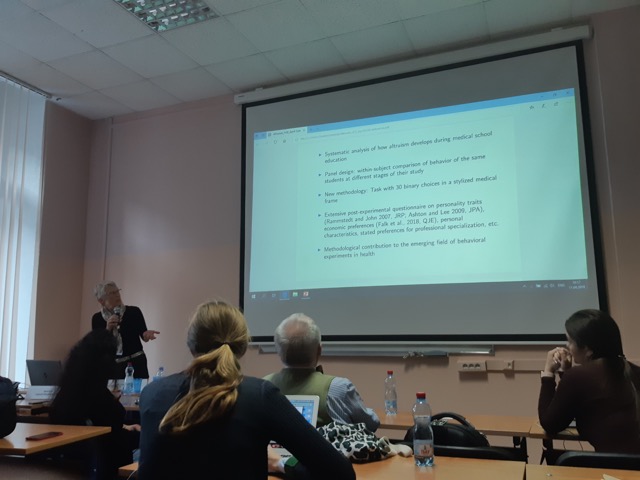Альтруизм в медицине: Первые доказательства экспериментального панельного исследования
Главный научный сотрудник Лаборатории Хайке Хенниг-Шмидт представила результаты эксперимента на XX Апрельской международной научной конференции в Высшей Школе Экономики.

Extended Abstract.
Authors: Arthur Attema, Matteo Galizzi, Mona Gross, Olivier l'Haridon, Heike Hennig-Schmidt, Daniel Wiesen
The assumption of altruistic preferences is key in modelling physicians’ behaviour (e.g., Arrow, 1963). While the importance of physician’s altruism, for example, in designing physician incentives schemes, has been largely recognized in theory, the empirical measurement of physicians’ altruistic preferences towards their patients is still in its infancy. The experimental evidence mainly supports the notion that altruistic concerns affect physician’s decisions while it also indicates substantial heterogeneity patient-regarding altruism (e.g., Godager and Wiesen, 2013). However, what determines the heterogeneity is not well understood. Also, evidence on how patient-regarding altruism develops over time (e.g, with medical students’ study progress) is still lacking.
In order to build the panel, we follow medical students at the University of Cologne over the course of their study. We focus on freshman, and student cohorts in their pre-clinical (first to second year), clinical (third to fifth year), and practical year (above fifth year), particularly considering those who are in their last year before progressing to the next stage. This panel design enables us to explore how altruism develops over time at a within subject-level considering important progress steps in medical students’ studies (e.g., involving exposure to patients starting in clinical studies). A comprehensive questionnaire including validated surveys on social preferences (Falk et al., 2018) and personality traits (Rammstedt, 2007; Ashton and Lee, 2007) enables us to investigate the link to various individual characteristics. We also collected medical students’ stated job-related preferences.
In the experimental task medical students are confronted with, they in a medical frame decide in the role of physicians between alternative treatment options for 32 stylized patients. For each patient, there are two treatment alternatives available. Each binary decision scenario contains a trade-off between the physician’s profit and the patient’s benefit. Decisions are incentivized by monetary rewards. The tradeoffs are systematically varied across decision alternatives, while one treatment option is always more patient-regarding and consequently provides less financial profit to the student when chosen. The total benefits accrued in the pool of patient’s health benefits are transferred to a charity and are exclusively dedicated to the treatment of cataract patients.
Our study comprises analyzing (i) whether medical students’ patient-regarding altruism differs with study progress (cross-sectional data analysis), (ii) how it develop over the course of study (panel data analysis), and (iii) how it relates to individual characteristics, such as demographics, social preferences and personality traits. Thereby, we are the first to assess the development of patient-regarding altruistic preferences over time and thus contribute to the economics literature on the stability of preferences (e.g., Andersen et al., 2008a,b). (iv) Finally, we analyze the relationship between patient-regarding altruism and stated speciality choices.
The cross-sectional analysis from the first-panel wave between April 2017and December 2018 (N=709) shows that medical students behave in a patient-regarding way with considerable heterogeneity in their behaviours. First of all, we find that patient-regarding altruism declines with study progress. In comparison to freshmen, the probability of choosing the patient-regarding treatment option decreases with study progress. The results further indicate that patient-regarding altruism is higher in the practical year compared to the pre-clinical and clinical study phases. Second, we find individual characteristics to relate to patient-regarding altruism. For example, there is a positive link between personality traits (i.e., agreeableness and openness) and altruistic treatment choices. Moreover, medical students revealing preferences for trust, general altruism and positive reciprocity are more likely to opt for the treatment with the higher patient benefit. In terms of stated job preferences, we find that medical students who state a preference for internal medicine or paediatrics have a significantly higher probability of choosing the altruistic treatment option. The data from the second wave of the panel will allow us to analyze the development of patient-regarding altruism at a within-subject level.
